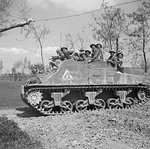davparlr
Senior Master Sergeant
Weights for the different models vary but the 1953 TM 9-2800-1 technical manual for Military vehicles gives the net weight of of the M3 halftrack (not the M3A1) as 15,500lbs, payload as 4500lbs and gross weight as 20,000lbs. Net weight is defined on page 1 of the manual as " Weight of the fully equipped vehicle in operating condition with fuel, lubricants, and water, but without crew or payload, unless otherwise specified."
The M2A1 half track is listed at 14,600lbs net, 5000lbs payload and 19,600lbs gross.
Max recommended towed load, cross country, is 4,500lbs but the British used them to tow 17pdr AT guns in the post war Army of the Rhine. maybe they had the 7.4 liter engine version?
Thanks, good data. Weight is always an issue with military equipment, especially aircraft. The big question is always "what does the weight include". That why I think "America's Hundred Thousand", recommended to me by Rerich, is such a treasured book. Too bad we don't have that kind of data on all the equipment.

